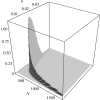Temporal trends in the discovery of human viruses
- PMID: 18505720
- PMCID: PMC2475551
- DOI: 10.1098/rspb.2008.0294
Temporal trends in the discovery of human viruses
Abstract
On average, more than two new species of human virus are reported every year. We constructed the cumulative species discovery curve for human viruses going back to 1901. We fitted a statistical model to these data; the shape of the curve strongly suggests that the process of virus discovery is far from complete. We generated a 95% credible interval for the pool of as yet undiscovered virus species of 38-562. We extrapolated the curve and generated an estimate of 10-40 new species to be discovered by 2020. Although we cannot predict the level of health threat that these new viruses will present, we conclude that novel virus species must be anticipated in public health planning. More systematic virus discovery programmes, covering both humans and potential animal reservoirs of human viruses, should be considered.
Figures





References
-
- Allander T, Andreasson K, Gupta S, Bjerkner A, Bogdanovic G, Petersson M.A.A, Dalianis T, Ramquist T, Andersson B. Identification of a third human polyoma virus. J. Virol. 2007;81:4130–4136. doi:10.1128/JVI.00028-07 - DOI - PMC - PubMed
-
- Bebber D.P, Marriot F.H.C, Gaston K.J, Harris S.A, Scotland R.W. Predicting unknown species numbers using discovery curves. Proc. R. Soc. B. 2007;274:1651–1658. doi:10.1098/rspb.2007.0464 - DOI - PMC - PubMed
-
- Chua K.B, et al. A previously unknown reovirus of bat origin is associated with an acute respiratory disease in humans. Proc. Natl Acad. Sci. USA. 2007;104:11 424–11 429. doi:10.1073/pnas.0701372104 - DOI - PMC - PubMed
-
- Cleaveland S, Laurenson M.K, Taylor L.H. Diseases of humans and their domestic mammals: pathogen characteristics, host range and the risk of emergence. Phil. Trans. R. Soc. B. 2001;356:991–999. doi:10.1098/rstb.2001.0889 - DOI - PMC - PubMed
-
- Dove A.D.M, Cribb T.H. Species accumulation curves and their applications in parasite ecology. Trends Parasitol. 2006;22:568–574. doi:10.1016/j.pt.2006.09.008 - DOI - PubMed
Publication types
MeSH terms
Grants and funding
LinkOut - more resources
Full Text Sources
Other Literature Sources
Medical
